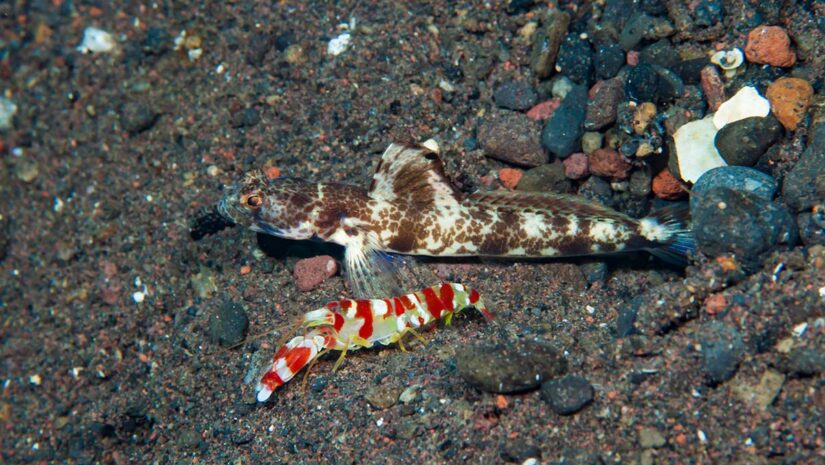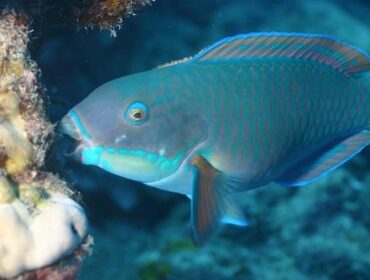The reef is full of interesting creatures that have evolved survival tactics to protect themselves from predators. This has led to some interesting partnerships between marine inhabitants. One curious partnership that divers are likely to encounter is that of the goby fish and pistol shrimp.
Throughout the Indian, Pacific, and Atlantic Oceans, species of gobiid fish form symbiotic relationships with species of pistol shrimp of the family Alpheidae.
Read on to learn just how goby fish and shrimp relate symbiotically and discover what goes on inside the burrows they share.
Pistol Shrimp: The Natural Burrowers
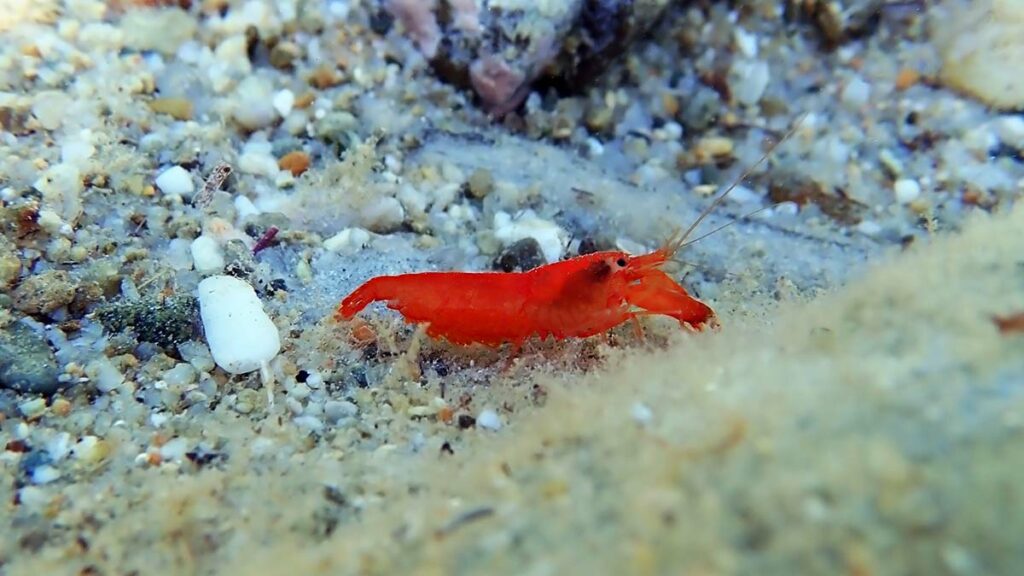
The pistol shrimp (or snapping shrimp) of the family Alpheidae is notorious for its large claws and digging abilities. It’s constantly creating and maintaining burrows in the seabed sand. However, the shrimp has very poor eyesight and being nearly blind, it’s extremely difficult for this species to spot their predators until it’s too late.
Known as natural burrowers, shrimps constantly clear out and build new burrows in shallow marine habitats, such as coral reefs, seagrasses, and mangroves. The shrimp provides food and a safe habitat for itself and the goby to live in by digging and maintaining burrows. However, the shrimp is very vulnerable to predators whenever it dumps gravel outside the burrow since it cannot detect potential threats. This is where goby fish comes in.
Goby Fish: The Marine Watchmen
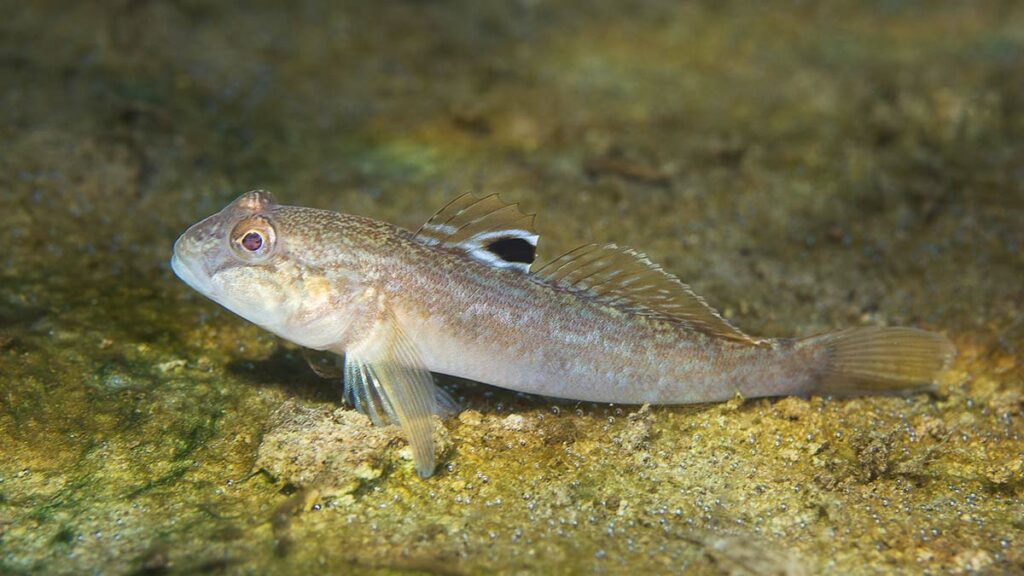
The goby fish of the Gobiidae family (in the genus Amblyeleotris, Cryptocentrus, Ctenogobiops, Istigobius, and Stonogobiops) are very small and vigilant fish with superior eyesight. These species form a symbiotic relationship with the shrimp by acting as its watchman against predators in exchange for shelter in the shrimp’s burrow.
The goby will usually sit at the entrance of the burrow, maintaining a constant vigil against potential predators, while the shrimp clears gravel from the burrow. The goby also uses the burrow for mating, which involves a lengthy ritual that requires a safe space.
With the goby keeping a lookout, the nearly blind shrimp places one tentacle on the fish while exposed, so if the goby darts inside the burrow, the shrimp is instantly alerted to the presence of a predator and it too darts back inside the safety of its burrow.
Is the Relationship Between Goby Fish and Pistol Shrimp Mutually Beneficial?
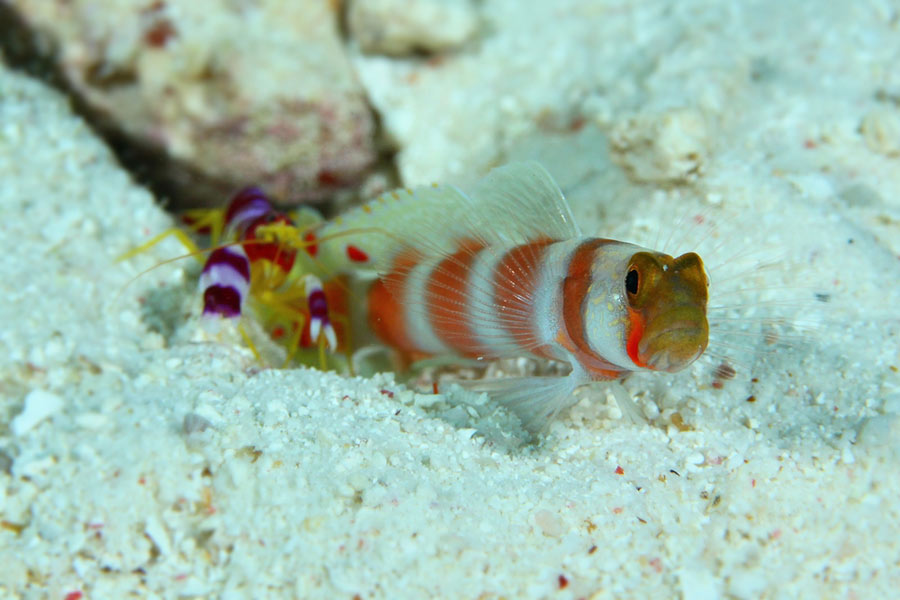
Before we answer this question, let’s first define what a symbiotic relationship is. Symbiosis is scientifically defined as the interaction between two different organisms that live in close physical association, usually to the advantage (though not always) of both parties.
A symbiotic relationship falls into three main categories:
- Mutualism (both organisms benefit from the relationship),
- Commensalism (only one organism benefits while the other neither benefits nor gets harmed), and
- Parasitism (only one organism benefits at the expense of the other).
The symbiotic relationship between goby fish and snapping shrimp is mutually beneficial. Studies have revealed that about 130 species of gobies associate with about 20 species of pistol shrimp, the majority of which live in the Indo-Pacific and nearby regions.
After a goby fish and pistol shrimp were discovered during a 1957 expedition in the Red Sea, a junior scientist named Luther caught a pair and placed them in a small fish aquarium to observe and study. Luther discovered that there was a significant association between goby fish and shrimp. Even when placed in the little tank, both species still kept in contact and soon started to build a new shelter in the tank’s sand.
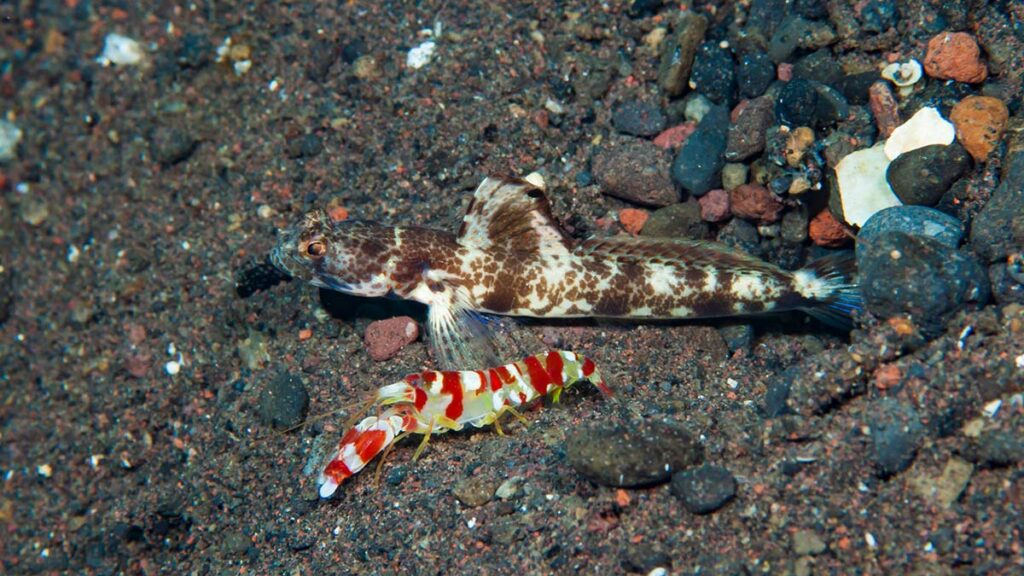
How Do Gobies and Shrimp Find Each Other?
If you’re wondering how gobies and shrimp find each other in the first place, know that there’s no definitive answer to this question. Marine biologists have been trying to figure out the origins of this partnership and have conducted numerous experiments to determine whether the gobies find the shrimp first or vice versa. They’ve also conducted experiments to try and figure out if the two species locate each other optically or are attracted chemically. To this day, the question remains one of nature’s enduring mysteries.
Feeding and Reproduction
Gobies eat micro-fauna, and sometimes, the tiny fish that they find near the bottom of the ocean. Meanwhile, the shrimps feed on what they find during their burrowing, and hence, do not compete with the gobies for food. While shrimp reproduction isn’t particularly remarkable, the reproduction of gobies bears some peculiar aspects.
During the mating season, the male and female gobies start a wild circular dance in an extended side corridor of the burrow. They stimulate each other from head to tail, which causes sand and gravel to fall from the ceiling. The shrimp’s digging action plays an important role in ensuring that the mating ritual continues, as gobies don’t have the ability to transport sand. Hence, the preparation of the gobies’ breeding chamber will only be possible with the shrimp’s assistance, resulting in a longer period of mating.
A Relationship that Lasts a Lifetime
Even more remarkably, the average symbiotic relationship between shrimp and gobi fish will last a lifetime. They begin bonding as juveniles and remain partnered as adults, spending their days foraging together and sharing a burrow. It is still unclear why these two species have developed such a high level of co-dependency, but the symbiosis works well for both organisms.
In exchange for the benefit of the goby’s eyesight, the shrimp digs and shares its burrow with the goby, and they dwell together in safety. These animals interact with each other on a highly complex level—and it becomes even more impressive when you realize that both species are in no way related.
Frequently Asked Questions
The pistol shrimp and goby share a mutualistic bond, where the goby acts as a lookout while the shrimp digs and maintains a burrow. The partnership benefits both species, leading to a preference for specific goby species that are compatible with each pistol shrimp.
While pistol shrimp can thrive without gobies, their symbiotic partnership offers significant advantages. Gobies serve as lookouts, warning the shrimp of potential threats, while the shrimp maintains and defends the burrow. However, pistol shrimp can survive independently, but the presence of a goby enhances their survival and territorial protection.
Conclusion
The symbiotic relationship between pistol shrimp and goby fish is a fascinating example of mutualistic cooperation in the marine world. The intricate bond they share benefits both species, with the goby acting as a vigilant sentinel and the shrimp providing shelter and protection.
This remarkable partnership underscores the intricacies and interdependencies within our ocean ecosystems, emphasizing the importance of preserving and understanding these delicate relationships for the benefit of our planet’s biodiversity and ecological balance.
Studying these extraordinary alliances can not only shed light on the wonders of nature but also inspire us to appreciate the beauty and complexity of life beneath the waves. By nurturing our oceans and safeguarding these remarkable creatures, we can ensure a sustainable and harmonious coexistence between all living beings on Earth.

